"Stay With Me..." MTB Injuries (Part 1)
Posted by Jeremy Windsor on Aug 12, 2021
I'll come clean straight away - I've only ridden a mountain bike a handful of times and know very little about the injuries that can occur. When I started researching this post I thought, rather foolishly, that these would be limited to cuts, bruises and the odd broken bone. But after reaching out to members of the mountain medicine community it turns out that I was completely wrong. Riders seem capable of snapping, tearing and puncturing just about every part of their body. Over the next few weeks I'll share what I've learnt. To start off, let's take a look at soft tissue injuries...
The upper limbs are often the first parts of the body to hit the ground so perhaps it's not surprising to learn that their skin and subcutaneous tissue is at particular risk. Here’s Samuel Parker, GP and DiMM holder, to talk us through a recent fall at Coed-y-Brenin…
“Elbow and knee pads are now on my 'essentials' list for trips to Wales. It's amazing how much damage loose scree can do to bare skin!
After a great day showing my girlfriend, my sister and her best mate around the trails (including a cheeky dip in the river half way round ;)), I headed to the Skills Park to knacker myself out. I hadn't realised how literally I would do so at the time.
I was on a hard tail rental bike with a worn rear tyre. I had tried the black skills circuit twice, but was too wuss each time to take on the last feature, known as Diagonal Slab, a slanting drop-off, about 4ft down into scree. The third time round I went for it. Immediately as I hit the ground I felt the rear tyre burst and the bike slid from underneath me.
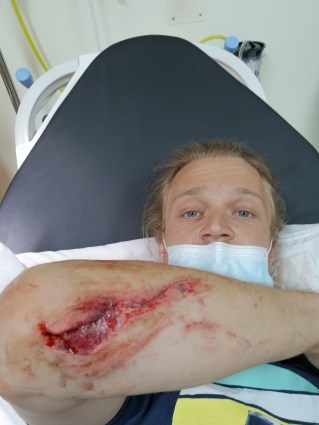
On arrival in MIU
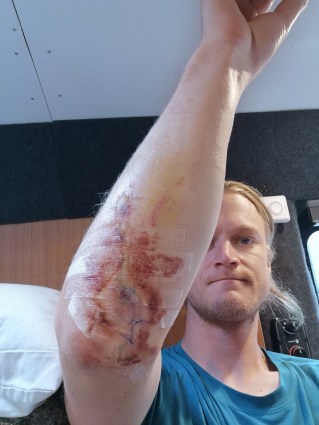
Day 3

Day 6
I got up, not in much pain at the time and looked down at my elbow - 'sh**, this needs some attention' I thought. I ran back to the centre and held my forearm under the nearest tap. We strapped it up, dropped my sister and her mate back at the camp and I headed to the nearest Minor Injuries Unit (MIU) with my girlfriend, half an hour away, where the wound was properly cleaned and closed by an experienced nurse practitioner. He was clearly well versed in these sort of injuries being in such close proximity to the slate quarries and Coed-y-Brenin...”
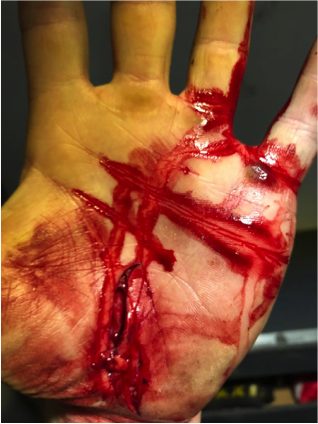
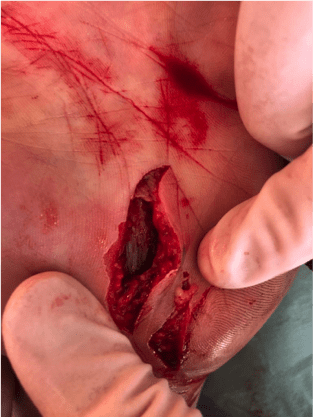
"Over the handlebars - an absolute classic, often caused by too much front brake, over rotating on a jump or rolling off a drop you probably should have popped off. The mechanism brings with it a remarkable range of results..." (Meg Owen)
Unfortunately, the lower limbs are also at risk. Even relatively minor falls can cause problems. Here's Meg Owen, an Emergency Physician, describing her many injuries...
"Lots of wet sloppy mud and not a lot of braking capacity. We were moving pretty slowly; I only skidded in the mud and came off the side of my bike on to my hands and knees – that just also happened to be on top of a gorse bush. Try standing up when you’re on your hands and knees in a gorse bush!
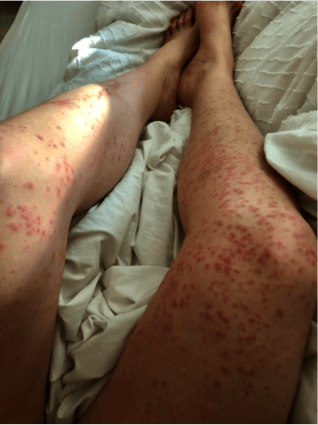
An uncomfortable landing
Now to a summer’s day on a harmless low gradient single track around a mountain, again I only came off the side of my bike at low speed. But because of the gradient of the hill, the ground to the right fell away. As did I. A grassy landing?!? – no chance".
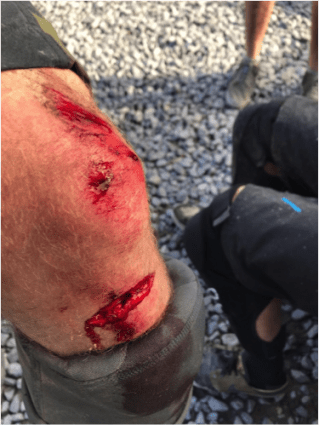
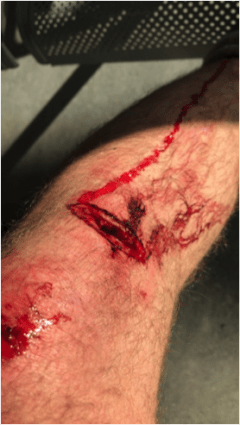
Most soft tissue injuries heal after a couple of weeks. However complications can sometimes develop. Here's one described by a sympathetic husband, “My wife had a fall off a wooden feature over a rock, knee pad slipped down and she landed on a sharp rock that caused a laceration through the prepatellar bursa, got washed out well at the ER, but unfortunately has some mild cellulitis … now she’s nursing that and jealous of the rest of us as we play and she heals”
The knees seem particularly vulnerable to soft tissue damage. As Meg brilliantly puts it,
"Everyone will do it eventually. Sutures likely, surgery a possibility".
Of course it's not only falls that can cause injuries. Contact between the pedal and shin can cause problems too,
"This one is a given and I’m not sure there is any way around it. Large platforms and aggressive pins make for a good grip with the soles of your shoes … or shin, they are not picky. Minimal dramatics, maximum grimace. I would recommend knee and shin guards but I guarantee that those pedals will still get you!"
What about contact with the back wheel?
"A more interesting mechanism - back wheel rotation whilst the bike is in the air. I’ve gone off a drop and stuck my bum too far back beyond the saddle and had a kiss on the bum cheek. No harm done. On a different occasion over a jump, my feet had come off the pedals and that back wheel has collected my ankle and taken it between the wheel and the frame. A little bit of friction rub not too much harm done. I’ve heard of a bloke who’s testicles followed the same journey. Pictures not available..."
Talking about testicles here's Simon Flower recalling an incredibly painful experience,
"I was descending off a hill somewhere in the Black Mountains about 20 years ago - I forget exactly where. The only bit of the ride I have a clear memory of is being presented with a farm gate, having rounded a bend at speed on a steep section of trail. I was less concerned than I might otherwise have been though - I was test driving some new technology: hydraulic brakes. Unaccustomed to this new stopping power, no sooner had I cranked on the levers than I was sailing over my handlebar. Much to my mate's lasting pleasure, I caught my scrotum on the stem as I went..."
Whilst it's hard to imagine a more painful area to injure it's a better option than damaging some of the major blood vessels nearby. Here's Mike Whiteside, Consultant Physician and DiMM holder, on a life threatening injury and a rather odd misprint,
"On descending from the Cat and Fiddle pub there is a long gravel track. Not technical but demands attention. I was racing my mate and somehow managed to go over the handlebars. I’m invincible so stood up quickly to shake it off, but thought on standing up there was a warm sensation in my inner shorts - I can’t have pissed myself? My exploratory hand came back covered in blood - there was a hole in my right groin! I immediately sat down, felt a bit faint and told my mate, John, a non-medic, what the deal was. I asked him to push on my groin as hard as he could whilst I tried to get some signal on my phone. John took off his top, rolled it up, stuffed it in my shorts and pressed hard.
Some 10 or so minutes later walkers came past and recognised there was an issue. They gave me some warmer clothes and ascended the gully for reception. I asked them to ask for mountain rescue and state I was a doctor with a vascular injury in my groin. By this point I was cold. John actually said ‘stay with me’. Then some trail bikers came past and placed their leathers underneath me to insulate me from the ground - all this time John was just wearing his t-shirt as his warm top was soaking up my blood.
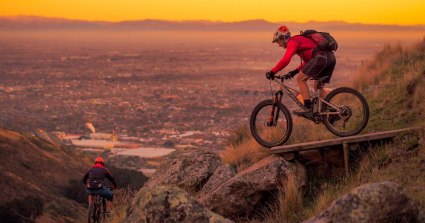
Working in Christchurch, Robin Baraclough has treated a number of injuries sustained at the city's Adventure Park, “The nastiest injuries can occur when not only the rider has been thrown off the bike at speed, (commonly getting a landing wrong, or hitting an obstacle), but as they go head first over the handlebars, the force of the impact causes the front wheel to suddenly jerk to one-side, forcibly turning the end of the handlebars (or brake lever) violently into an abdomen, groin or thigh as they go past. I know of a Grade IV* spleen injury in a young adolescent caused in this exact way…”
After 40 minutes Buxton Mountain Rescue Team arrived, all 23 of them. I was zipped up, given a quick once over and a drip. They then carried me down the hill to a waiting helicopter. At this point I was feeling a lot better and asked the helicopter paramedic if they could take me to the Northern General Hospital in Sheffield. He replied ‘this ain’t fucking BUPA mate’ and I ended up in Wythenshawe Hospital instead.
Stripped naked in ED and surgery that evening. It was a torn perforator vein in my groin. I received a 5 inch cornish pasty-shaped scar and a night on the ward. It made me realise just what being a patient is like. Interestingly, my brake lever was bent double but there was no rip in my shorts!
Fast forward 1 year and I got married - no wedding list, just a request to donate to Buxton Mountain Rescue Team - £2500 raised, a radio interview plus 3 local newspaper articles in which one stated I’d actually married my mother in law!"
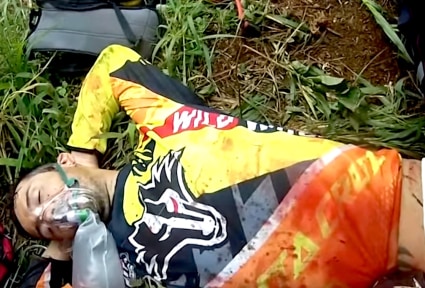
To get a sense of what it's like to sustain a life threatening vascular injury in a remote setting take a look at this!
In some cases the significance of the injury is missed. Here's Paddy Morgan, a Trauma Team Leader and Consultant Anaesthetist, on an intra-abdominal injury that was ignored,
"Some of the higher speed crashes have involved visceral injuries - in particular, splenic ruptures, bowel ruptures, liver lacerations and pneumothoracies. The last case like this was found 4 hours after the initial event on the hard shoulder of the motorway semi conscious in the back of his van. Apparently he felt sleepy so lay down - with his systolic of 55mmHg due to a liver laceration and a splenic rupture..."
I thought this sober warning would be a good place to stop. But then something arrived in my inbox that really stopped me in my tracks. Whilst the majority of MTB injuries are normally due to rider error this incident shows that other factors may also play a part. Here's Nick Fisher, GP and Emergency Physician, to pick up the story,
"The South Chilcotin area of British Columbia is a popular hiking and mountain biking destination - the terrain provides opportunities to ride from subalpine forest to alpine meadows, exposed ridges and peaks of up to 3000m elevation. It is also home to large populations of wild animals including wolves, deer, black and grizzly bears. Encounters are rare and generally benign, but occasional attacks occur.
We received a call via a satellite communication device in August 2020 alerting SAR to a bear attack on a mountain biker in the Chilcotin. The injuries were described as severe but the casualty was stable. We were able to establish their location quickly and flew there via helicopter from Pemberton base.
The mountain biker had been riding in subalpine gladed forest below a large ridge along a well known but less frequently travelled trail. He described hearing a crashing sound from the woods on the left, then seeing a large set of jaws grab him by the head. He was shaken by the head several times before being mauled by the bear's claws across his groin. His wife, who was close behind, was able to repel the bear using bear spray. Significantly, she noted that there were 3 small cubs with the bear.
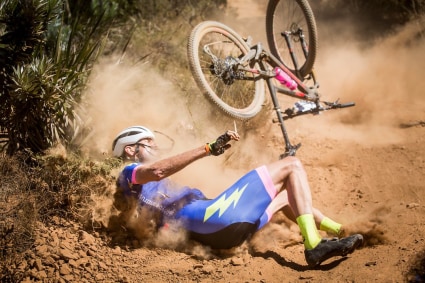
Researching this post it soon became clear that MTBer’s are vulnerable to a wide range of soft tissue injuries. Here's Paddy Morgan recalling one or two unusual cases, "Disturbing a wasps nest following a fall (very swollen head after all the stings...), MTB versus deer, stuck up a tree and "Face Off” whereby a MTBer walked into the ambulance holding his face having de-gloved his forehead, and leaving his nose somewhere in the gravel…"
The biker sustained a superficial head injury - his helmet having protected him from the majority of the injuries. He also had a large wound at the top of the thigh, which when exposed revealed his femoral artery visibly pulsing but not damaged with no significant haemorrhage. He sustained several broken ribs, but no underlying organ injury to chest or abdomen.
Medical intervention consisted of pain and wound management. He was heli-evacuated to a large alpine clearing and subsequently transferred to an air ambulance and onwards to Kamloops hospital.
This was deemed a defensive attack by a mother grizzly bear defending her cubs and the decision was made by the Conservation Officers not to destroy the bear."
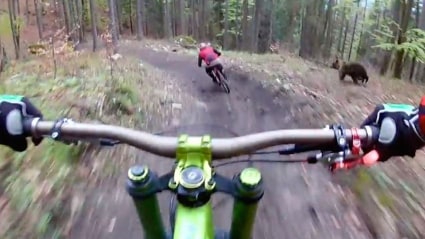
The growing popularity of mountain biking in remote parts of North America means that contact between humans and wild animals looks set to increase. This poses a risk to both. As researcher Courtney Larson says, "We can't make an assumption that recreation is a benign use of conserved lands" and the long term survival of animals such as elk and many species of bear may be at risk from increasing human contact
Nick goes on to make some very useful recommendations,
"Make noise at all times while in bear country, especially when moving fast and sight lines are limited, for example on a mountain bike descent trail in forested areas. Bears often respond aggressively when surprised, especially when defending their cubs.
Always wear a helmet. This subject was saved from severe head injury by one.

The result of being held in the jaws of a bear...
Carry bear spray. Studies have found that bear spray is an effective deterrent for grizzly and other bears in close encounters. If riding in a group, all members should have a personal canister of spray and it should be easily accessible on the body, not attached to the bike or in a pack.
Don't ride alone, and ensure that there’s access to a satellite communication or PLB device. This couple was a minimum of 2 hours of further riding from assistance. They were well prepared, with first aid kits and emergency gear appropriate to the remoteness of their location."
On that rather stunning note I'll finish and say a big "Thank You" to Robin Barraclough, Andy Elsberg, Nick Fisher, Paddy Morgan, Quentin Otto, Meg Owen, Sam Parker and Mike Whiteside. Without their help this post would not have been possible.
Next time we'll take a look at bony injuries...
*According to the American Association for the Surgery of Trauma (AAST) spleen injuries are categorised I to V. A Grade IV injury involves damage to the spleen’s blood vessels and devascularisation of more than 25% to the spleen tissue.
Comments
Leave a comment.
Leave a comment.



 )
)